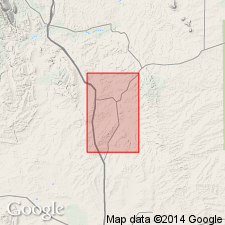
- Usage in publication:
-
- Parkman sandstone member*
- Modifications:
-
- Revised
- AAPG geologic province:
-
- Wind River basin
Summary:
Designated as a member (one of five members) of the Pierre formation of the Montana group in the Salt Creek oil field, Ts38 to 41N, Rs78 and 79W, Natrona Co, WY in the Wind River basin. Lies 2,300 ft above base of Pierre and 1,000 ft below top of the Pierre. Is 350 ft thick. Forms a striking escarpment. Fossiliferous (turtles, crocodiles, ammonite). Divisible into a basal shaly sandstone about 40 ft thick, middle white to buff sandstone 100 ft thick, and an upper interbedded thin coal, dark shale, and white sandstone 125 ft thick. The upper beds have a striking appearance. Of marine and fresh-water origin. Late Cretaceous age.
Source: GNU records (USGS DDS-6; Denver GNULEX).
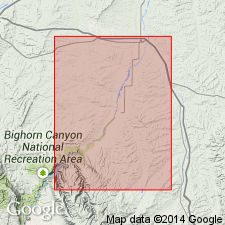
- Usage in publication:
-
- Parkman sandstone*
- Modifications:
-
- Mapped 1:63k
- AAPG geologic province:
-
- Powder River basin
Summary:
Mapped in northeasternmost part of study area Big Horn Co, MT, northwestern Powder River basin. As shown on measured section (sheet 2), Parkman is 254 ft thick; lower part consists of 109 ft of shale that becomes silty to very sandy upward; upper part consists of 145 ft of buff, brownish, and olive-green sandstone that forms west-facing sandy hills. Assigned to Montana group. Overlies Claggett shale member of Cody shale (revised); underlies Bearpaw shale. Late Cretaceous age.
Source: GNU records (USGS DDS-6; Denver GNULEX).
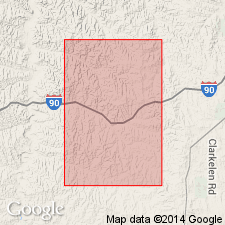
- Usage in publication:
-
- Parkman sandstone
- Modifications:
-
- Revised
- AAPG geologic province:
-
- Powder River basin
Summary:
Revised in that stratigraphic rank of Parkman raised; it is assigned as the basal formation of the Mesaverde group (rank raised in report area) in the Powder River basin of WY. Grades downward into the Steele shale. Is overlain by 170 ft thick marine shale that merges eastward with the Pierre shale of the Black Hills. This marine shale is designated a tongue of the Pierre. The upper formation of the Mesaverde in this basin is the Teapot sandstone (formerly assigned member rank in the Mesaverde formation). Divided into an unnamed member (lower) and the overlying newly named (in sequence) Dead Horse Creek (middle), and Ferguson (top) members. Described as a marine sandstone deposited during a marine regression in which the strandline retreated seaward (or eastward). The basal unnamed member is sandy silty shale about 200 ft thick transitional between the top of the underlying Steele to the base of the Dead Horse Creek member. The overlying Dead Horse Creek and the Ferguson are composed of sandstone. E-log cross section. Of Late Cretaceous age.
Source: GNU records (USGS DDS-6; Denver GNULEX).
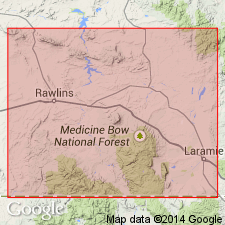
- Usage in publication:
-
- Parkman Sandstone Member*
- Modifications:
-
- Areal extent
- AAPG geologic province:
-
- Wind River basin
- Powder River basin
Summary:
Is a member of the Mesaverde Formation in the southeastern Wind River basin where it overlies the Wallace Creek Tongue of Cody Shale, and in the Powder River basin where it overlies the Steele Shale. Correlation with other units of late Campanian age or Late Cretaceous age, shown on Table 1.
Source: GNU records (USGS DDS-6; Denver GNULEX).
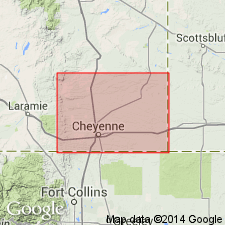
- Usage in publication:
-
- Parkman Sandstone Member*
- Modifications:
-
- Areal extent
- AAPG geologic province:
-
- Denver basin
Summary:
Nomenclature applied to divisions of the Pierre Shale in exposures at Francis Ranch, secs 7-10 and 15-16, T14N, R69W and in subsurface in Apache Corp. 1 Polo Ranch, sec 14, T14N, R68W, Laramie Co, WY, Denver basin modified. Term: 1) Gammon Ferruginous Member replaces use of lower transition zone; 2) Mitten Black Shale Member replaces use of rusty zone; 3) Hygiene replaces use of the subsurface Sussex; 4) Rocky Ridge, Larimer, and Richard Sandstone Members replace use of the subsurface Parkman. Terry Sandstone Member of Pierre in the Fort Collins, CO area is equivalent to the subsurface Sussex and is not present at Francis Ranch or in the Apache Corp. well. Use of Shannon, Sussex, and Parkman is discontinued in the Denver basin because the sandstones of the Denver basin are not time-equivalents or time-transgressive facies of the Shannon, Sussex, or Parkman of the Powder River basin. As modified, divisions of Pierre are (ascending): Gammon, Sharon Springs, Mitten, Hygiene Members, unnamed interval, Rocky Ridge Sandstone Member, unnamed interval, Larimer Sandstone Member, unnamed interval, Richard Sandstone Member, unnamed interval, units A, B, C, unnamed interval. Pierre overlies Niobrara Formation and underlies Fox Hills Sandstone. Of Campanian age. Measured section; nomenclature chart.
Source: GNU records (USGS DDS-6; Denver GNULEX).
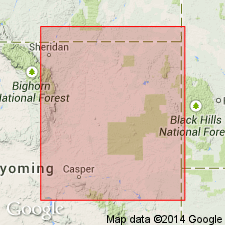
- Usage in publication:
-
- Parkman Sandstone Member*
- Modifications:
-
- Areal extent
- AAPG geologic province:
-
- Powder River basin
Summary:
Mesaverde Formation identified in the subsurface of the western and southern Powder River basin (Converse, Niobrara, Johnson, Sheridan, western Campbell Cos, WY and Big Horn Co, MT) where it overlies Steele Shale and underlies Lewis Shale. Mesaverde divided into the Parkman Sandstone Member at base, unnamed middle part, and Teapot Sandstone Member at top. Eastward in the basin, the Steele, Mesaverde, and Lewis are replaced by the Pierre Shale. The Parkman is the equivalent of the Red Bird Silty Member of the Pierre. Late Cretaceous age. [Shown on many cross sections in this OC series.]
Source: GNU records (USGS DDS-6; Denver GNULEX).
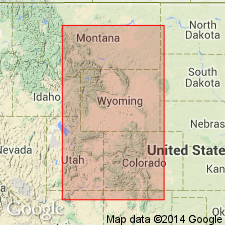
- Usage in publication:
-
- Parkman Sandstone Member*
- Modifications:
-
- Biostratigraphic dating
- AAPG geologic province:
-
- Central Montana uplift
Summary:
Is a member of Judith River Formation. At stratotype of palynostratigraphic zone AQUILAPOLLENITES SENONICUS Interval Zone in Fergus Co, MT, [Central Montana uplift] lower boundary of A. SENONICUS Zone is 34 m above base of Eagle Sandstone and upper boundary of A. SENONICUS Zone is placed about 76 m above base of Parkman. Thus lower part of Parkman is within A. SENONICUS Zone. A. SENONICUS Zone is assigned late early to early middle Campanian age (81-79 Ma). [Not definitive if lower part of Parkman is early Campanian age.] A. SENONICUS is probably equivalent to interval included by zones of ammonites BACULITES sp. (either species known as "smooth" or "weak flank ribs") through B. ASPERIFORMIS. Lower boundary of overlying palynostratigraphic zone AQUILAPOLLENITES QUADRILOBUS Interval Zone is 76 m above base of Parkman and extends through middle and upper parts of Judith River Formation. A. QUADRILOBUS Zone is assigned early middle Campanian through late (but not latest) Campanian age (79 to 73 Ma). [Thus Parkman is middle and late Campanian age and possibly early Campanian.] A. QUADRILOBUS is probably equivalent to interval included by zones of ammonites BACULITES PERPLEXUS through B. CUNEATUS.
Source: GNU records (USGS DDS-6; Denver GNULEX).
For more information, please contact Nancy Stamm, Geologic Names Committee Secretary.
Asterisk (*) indicates published by U.S. Geological Survey authors.
"No current usage" (†) implies that a name has been abandoned or has fallen into disuse. Former usage and, if known, replacement name given in parentheses ( ).
Slash (/) indicates name conflicts with nomenclatural guidelines (CSN, 1933; ACSN, 1961, 1970; NACSN, 1983, 2005, 2021). May be explained within brackets ([ ]).

